AUTUMN
2006 - part 4: On the theme of Cloudspotting....
BACK TO WEATHER-BLOG MENU
New! Fine Art Prints & digital
images for sale-
Welsh Weather & Dyfi Valley landscapes Slide-Library
- Click HERE
Autumn continued with the full fury
of an active Atlantic unabated and at the time of writing
(December 5th) it is around 14C at 0800 with a SW-erly
gale blowing. Some winter so far! It's supposed to begin
in December after all!
During the last 7 days the UK has seen straight-line wind
gusts to over 100mph, torrential rain, a vigorous
line-squall and a significant tornado which, conveniently
in terms of accessibility, touched down less than 20
miles from here, but caused great distress to residents
of Bow Street, the village near Aberystwyth that it
struck. I was able to get there that morning and commence
a site-investigation on behalf of TORRO, the results of
which are in the process of being written up. All going
well, a detailed account will be posted on this site
within a week. I've been busy to put it mildly!
This page deals with a late Autumn storm-chase to SW
Wales - another one of my expeditions! But first, a
little book-review....
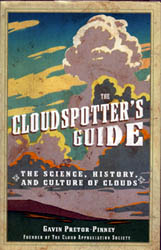 I am grateful to Katie Wasilewski of Perigree Books (part of the Penguin Group) for sending me a copy of the hardback edition of the Cloudspotter's Guide, by Gavin Pretor-Pinney (published June 2006, ISBN: 0-399-53256-0). Gavin is a man who likes clouds. In fact he loves them, and the sheer enthusiasm that he has runs like electricity through this book. In 2004, he founded the Cloud Appreciation Society for a bit of fun. They now have thousands of members! On their website, http://www.cloudappreciationsociety.org/, is a manifesto which includes the following: "We pledge to fight ‘blue-sky thinking’ wherever we find it. Life would be dull if we had to look up at cloudless monotony day after day." So to the book itself. It is divided into five sections. The first one is introductory and is followed by sections on low clouds (these in terms of cloud-base); middle clouds (clouds whose names begin with "alto") and the high clouds (clouds whose names begin with "cirro"). Finally there is a section on all clouds that do not conveniently fit into the above! Gavin freely admits that this is not an academic meteorological text - but that shouldn't put anybody off! The book is packed with facts about each type of cloud and anybody with a passing interest in the skies overhead, and who wonders what all the various clouds are called, will find their answers in here. They will also find all sorts of stuff about clouds in history and folklore, clouds and aviation, traditional cloud-names (the account of his quest in Billingsgate fish-market to find a fish that actually looked like "mackerel-sky" is sheer entertainment), optical effects and much much more. The only criticisms I can find are in the section on cumulonimbus ot thunderstorm clouds. This jumps about a bit and there are a few technical points I would like to see addressed - but then after all I'm a nerdy thunderstorm enthusiast and TORRO staff member! This book isn't just written for the hardcore follower of thunderstorms and all of their manifestations. It's for everybody who looks up (instead of down, which far too many people do) and wants to know what's going on in the sky! Wittily and enthusiastically written, it is a great read for all ages. Recommended! |
|
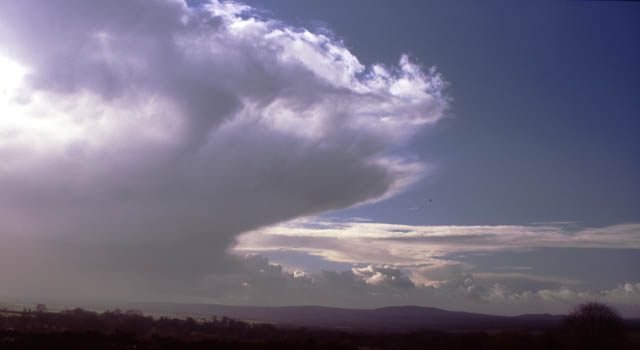 So, on to the November 23rd chase. Early morning radar images suggested a concentration of activity coming into the SW of Wales and, needing little excuse to visit this beautiful area I headed off. First decent thing I came across was this cumulonimbus, seen to the S from the A487 near Aberporth.... |
|
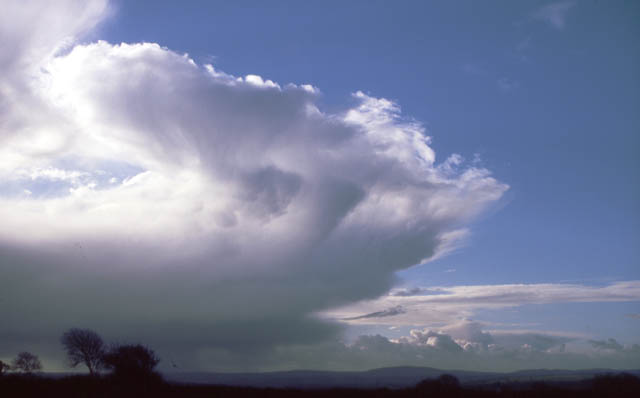 Feeling this might generate more nice images I tried heading across-country in the direction of Newcastle Emlyn. This proved to be a bad move with lots of good chances thwarted by overhead cables along the roadside - I hope they put these below ground soon - they'll be doing us cloud-photographers such a huuuge favour! |
|
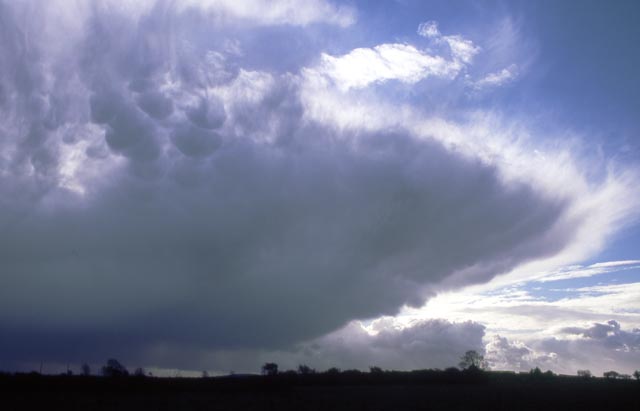 This was about the only vantage point I managed to find and by the time I had the mammatus display had deteriorated a fair bit. You win some, you lose some..... |
|
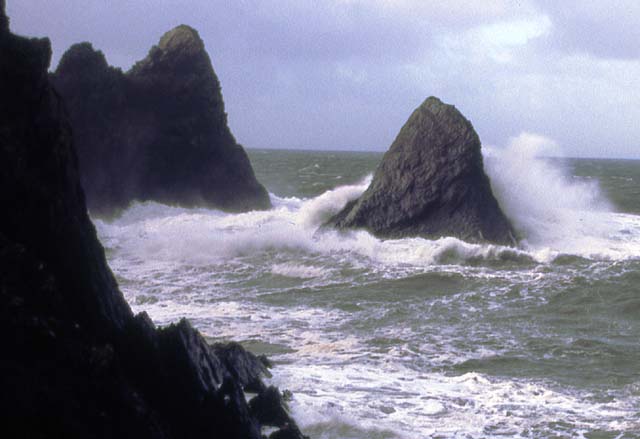 Seeing as it was a blustery day with gale-force winds, I called at Ceibwr Bay to catch a few waves... |
|
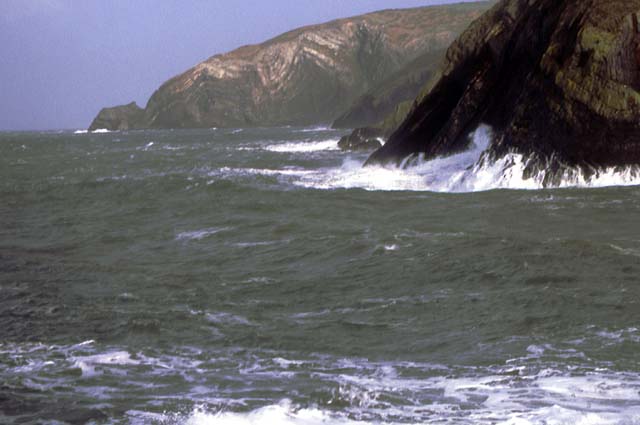 Big swell running. This place would be truly spectacular in a full-on Atlantic storm, although great care would be required as the waves can break over the rocks where such photos are taken... |
|
 Continuing onwards this was the last Cb I saw! Another Pembrokeshire bust! This was just outside Fishguard. I decided to continue on SW anyway for the hell of it... |
|
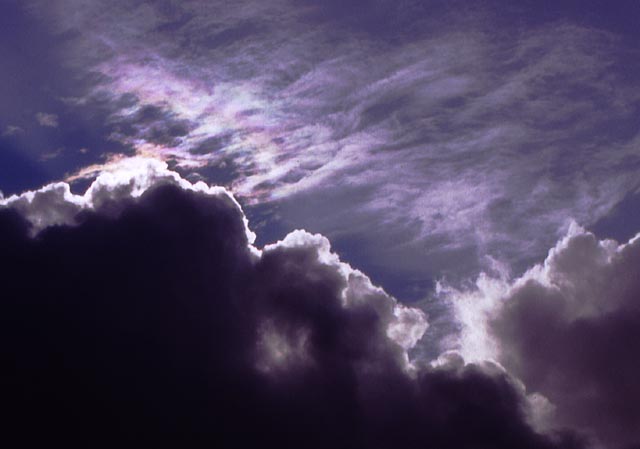 ...and was rewarded with a few tidy images. Here, high-level cloud (consisting of ice-crystals) is displaying iridescence. This may occur when clouds are a) thin and b) contain water droplets or ice crystals of a fairly uniform size. Diffraction of sunlight is what makes them shine with these mother-of-pearl colours. The colours are usually to be seen in patches or bands at cloud edges, and they change as the relative position of the cloud and the indiodent sunlight changes. The sun is just behind the bank of cumulus cloud. |
|
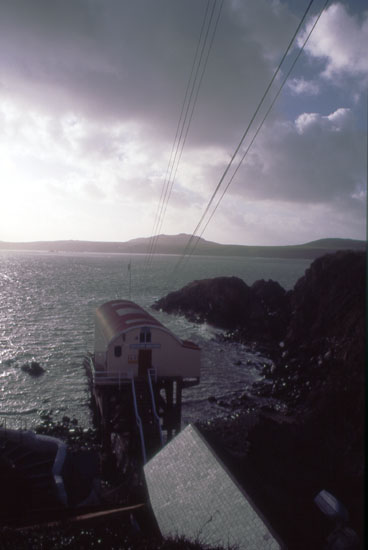 Onward and westward I arrived as St Justinian, to the west of St Davids. This is the launching station for the lifeboat, which covers the waters around St Davids Head and Ramsey Island, seen here across the sound. These are dangerous waters for the inexperienced or under-equipped. On a big Spring tide, the tides at the narrowest part of the Sound may exceed 10 knots! It is a beautiful area though, and the whole of the Sound may be explored by following the excellent Pembrokeshire Coastal Footpath... |
|
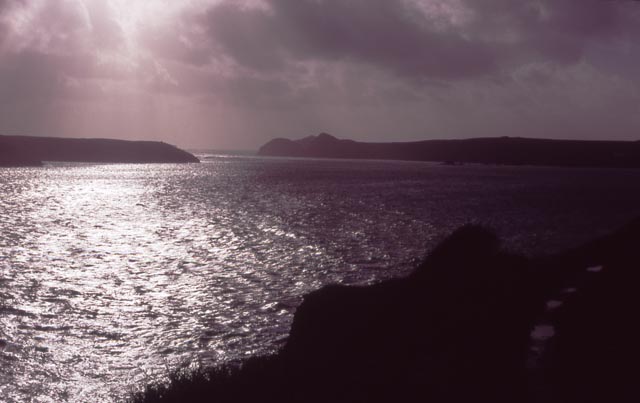 ...this is looking out from the footpath just around from the lifeboat station towards the narrowest part of Ramsey Sound. Beautiful even on a rough day! |
|
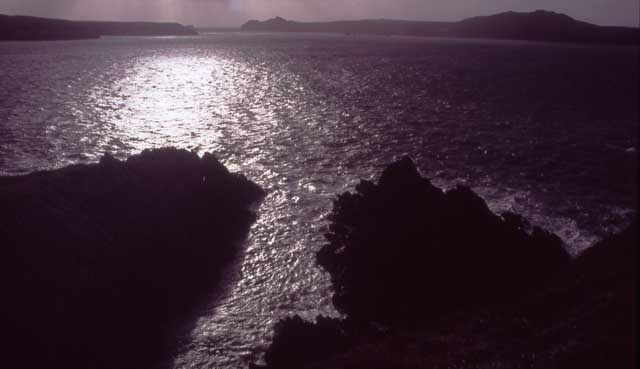 These were taken by exposing for the bright sunlight, thus underexposing exerything else to silhouette the land. The rocky reefs made an interesting foreground but conditions were getting rougher with a buffeting gale ushering me back and onwards with the trip.... |
|
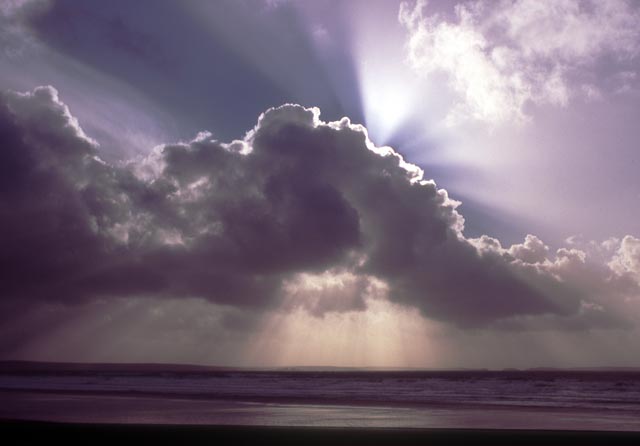 This is at Newgale, looking across the sand towards Wooltack Point. Moisture in the air is scattering the sunlight, making it show up as rays: the diveregence is simply down to perspective (as railway tracks appear to move closer together when you look down the line, when one knows full-well that they are parallel). Good day for optics, this! |
|
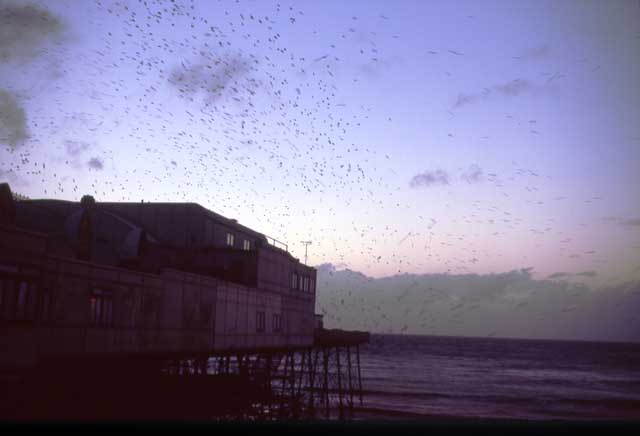 It was shortly homeward-time, but I managed to catch the starlings at Aberystwyth Pier at last light to finish the day off. There are literally thousands of them roosting there these days and they've become quite an attraction. Just this once, though, don't look up! The jeep was soon spattered ! I reckon some really weird effects could be got here with long exposures. |
|
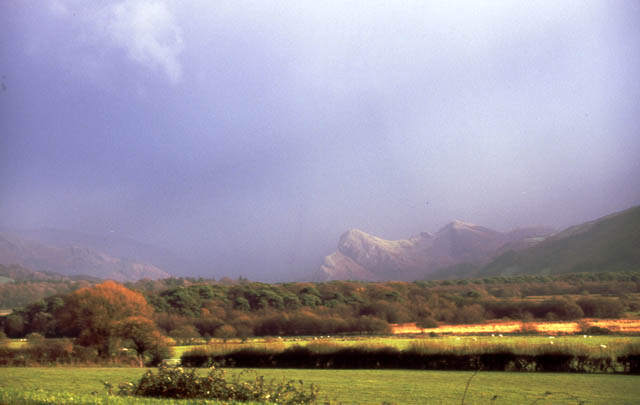 This was taken at lunchtime on Monday 27th November as a particularly messy-looking thunderstorm cleared Craig-yr-Aderyn (Bird Rock). Gave some good flashes and rumbles. The most interesting thing though is the amount of trees still in leaf. There is definately something weird going on with our seasons. I am convinced of that. Only 12 hours later, the residents of Bow Street found themselves in the middle of a night they will never forget. Details coming soon.... |
|
BACK TO WEATHER-BLOG MENU New! Fine Art Prints & digital images for sale- Welsh Weather & Dyfi Valley landscapes Slide-Library - Click HERE |